Performance Max is one of Google's latest advertising campaign types, designed to save you time and money. With Performance Max, you can access all Google Ads inventory from a single campaign, easily tracking and optimising your campaigns for maximum performance. This post highlights the differences between Performance Max and Smart Shopping, with tips on how to get the most from a retail-focused campaign. If you'd like an overview of Performance Max campaigns, check out our Complete Beginner's Guide to Google Performance Max.
For advertisers who have previously run Google Ads Smart Shopping campaigns, as of September 2022, these will have been automatically upgraded to Performance Max, which has now replaced Smart Shopping.
When you create a new campaign in Google Ads and want to focus on product ad campaigns with the powerful automated features of Smart Shopping, your only option is now Performance Max.
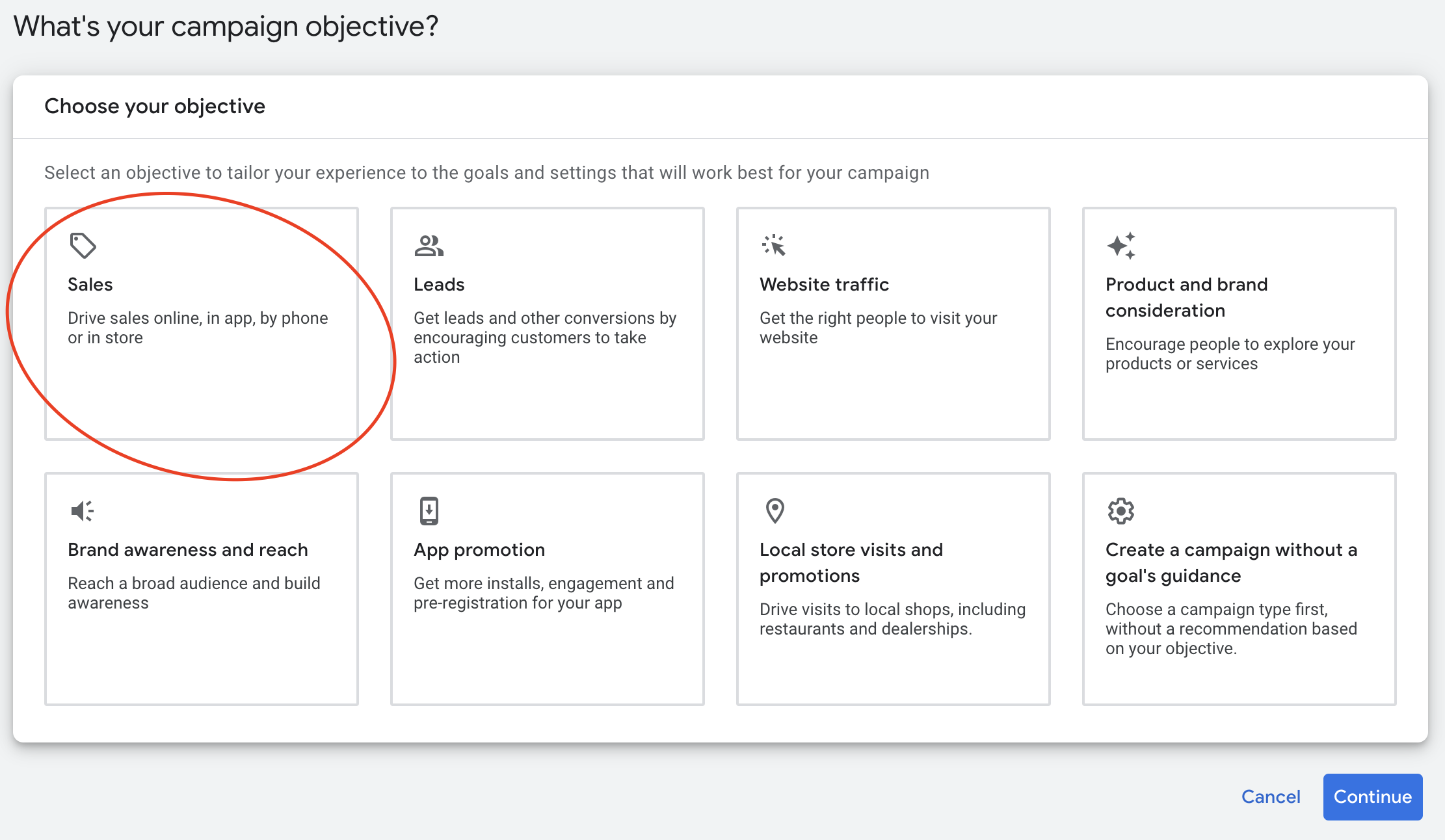
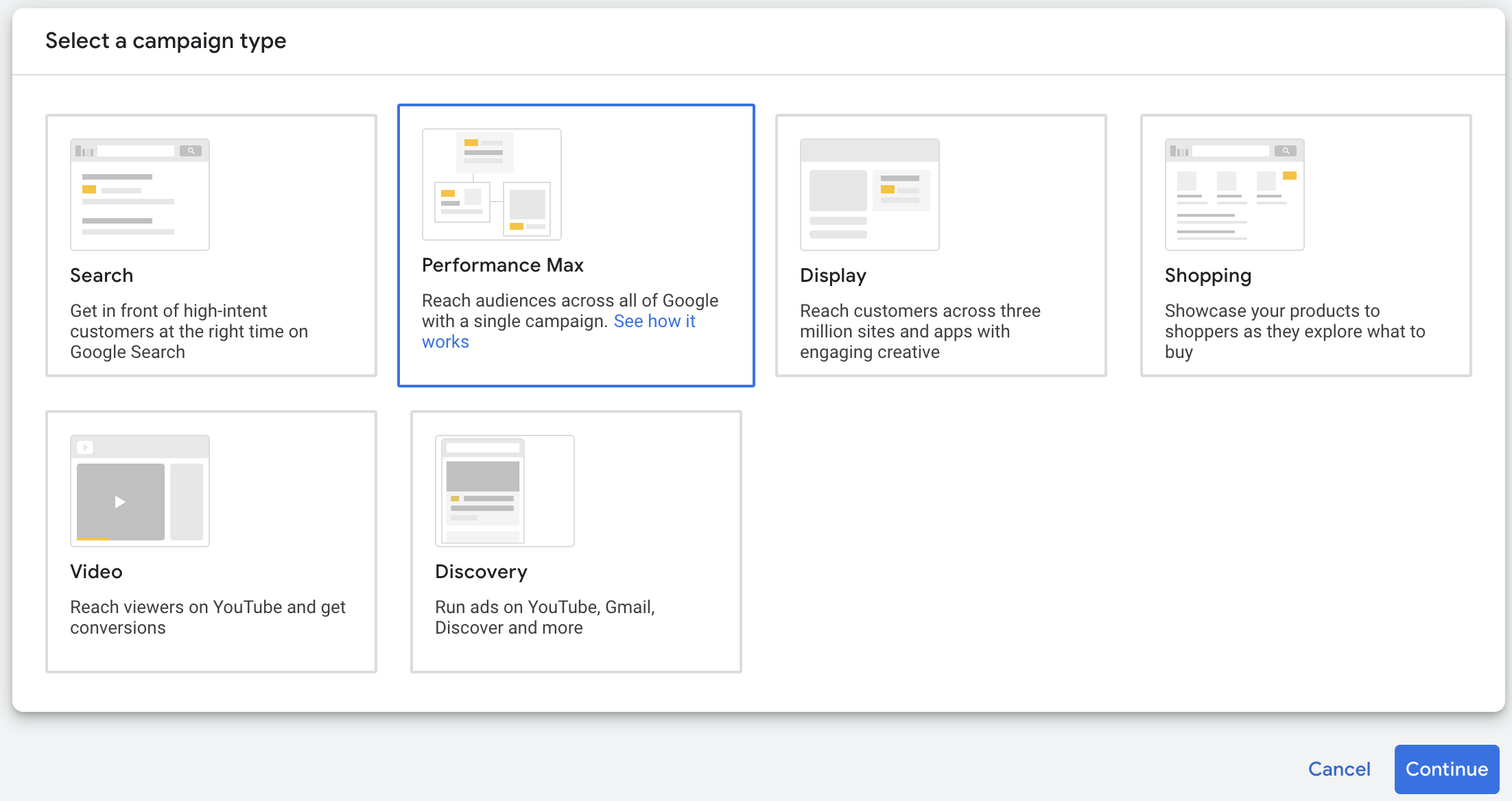
Performance Max vs Smart Shopping
Performance Max campaigns offer retailers more visibility across all Google Ads channels, including YouTube, Search, Display, and Discover. Additionally, Performance Max campaigns feature a broad range of different ad formats, such as Display Ads, Text Ads, Shopping Ads, etc, allowing advertisers to reach all of the Google Ads channels from a single campaign.
In comparison, the old Smart Shopping campaigns only covered Google Shopping ads and Local Inventory ads.
So Are Performance Max Campaigns Right For Online Retailers?
The decision of whether or not to use Performance Max campaigns for eCommerce depends on what you need from your advertising. If it's a convenience and control of basic insights, this type of advertising model should be perfect for you. Plus, with Google’s real-time data on shopper intent, Performance Max can help you identify and target new audience segments that might have otherwise gone unnoticed. This system works well for eCommerce advertisers who want to dip their toes into all of Google’s advertising platforms from a single campaign – especially if they are new to promoting their business through Google Ads or smaller businesses who don’t want to get too much into strategy.
Once creative assets are loaded into the campaign, Google figures out when and where your ads will appear across its advertising channels, including YouTube, Display, Search, Discover, Gmail, and Maps, serving the ads to wherever your ideal audience is most active. Although it has multiple advantages, Performance Max doesn’t offer established retailers the same opportunities for growth as other campaign management options, as it lacks transparency regarding search query data, the share of voice, and any control over ad placement that regular Shopping campaigns provide.
Ultimately, Performance Max works best as an enhancement to Smart Shopping campaigns by adding more placements and increasing reach. If you feel that Performance Max is right for you, you should read more about How to strategise for e-commerce success with Google Performance Max.
When NOT To Use Performance Max
There are a few situations in which you might not want to use Google Performance Max:
1. If you have a very limited budget: Google Performance Max is designed to maximise ROI, which means it will bid aggressively to try and get as many conversions as possible. If you have a very limited budget, you might not want to use the bidding strategies PMax offers, as it may lead to rapid spending of your budget.
2. If you have specific targeting or budget constraints: If you have specific targeting or budget constraints that you want to adhere to, you might not want to use Performance Max because it will adjust your bids and targeting to maximise ROI rather than prioritising certain products, for example.
3. If you have limited data:Google Performance Max relies on machine learning algorithms to optimise bids and targeting. These algorithms need data to learn from to make informed decisions. If you have a limited budget, a limited catalogue size or the nature of your products leads to low traffic levels. Google may find it hard to formulate a strategy from its learning phase.
Overall, whether or not you should use Google Performance Max will depend on your advertising goals and the specifics of your campaigns. If you have specific targeting or budget constraints, or if you have limited data or a very limited budget, you might want to consider using different campaign types, such as Search Ads or Standard Shopping, as with these types of campaigns, you'll be able to retain more control.
Does Performance Max Include Shopping Ads?
Performance Max is based on establishing goals and targets, with ad placement and bidding totally automated. Yet, the classic Shopping Ad format is part of the Performance Max ad inventory.
Product groups are used within Performance Max campaigns in much the same way they were used for Smart Shopping Campaigns, which draw content from your product feed in Google Merchant Center. In Performance Max campaigns, these product groups are added to 'Asset Groups', which are unique to this campaign type. Assets are essentially what make up the content of your ads. To learn more about how these work, make sure to read our Guide To Google Performance Max Assets & Asset Groups.

Free Report
Spot Errors, See Strategies,
Our Free Report Reveals Key E-Commerce Fixes.
Book Your Call
How To Assess What Shopping Activity Is Coming Through Performance Max
With Performance Max campaigns in place, it can help you target users who are most likely to be interested in your products, but it’s important to be mindful of how much money you’re spending on these campaigns. If you’re targeting users across too many networks, you can waste a significant amount of money.
Gathering an idea of how much of your traffic is coming from Performance Max Smart Shopping activity is essential. This is impossible to view inside Performance Max campaigns but can be assessed through a custom report following the steps below.
1. Sign in to your Google Ads account, navigate to the "Reports" tab, select the 'Dashboards' tab, and create a new dashboard by clicking the '+' button.
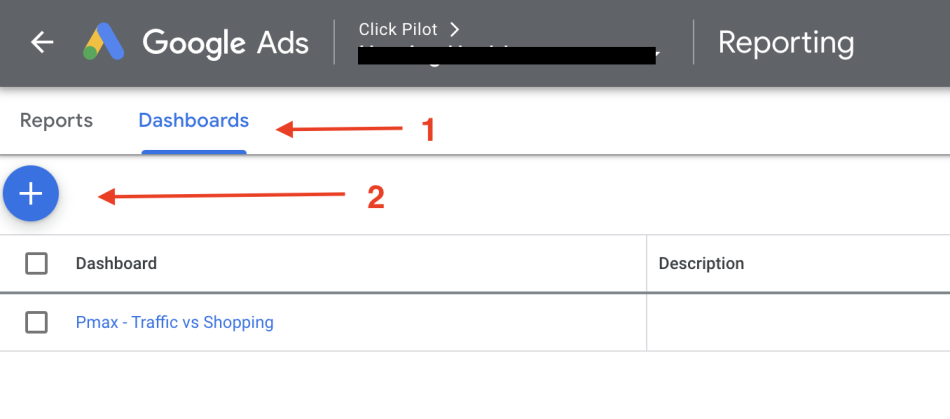
2. Once in the new Dashboard creator, select the '+' button to add a new report, and select the report from the drop-down, followed by 'New report.'
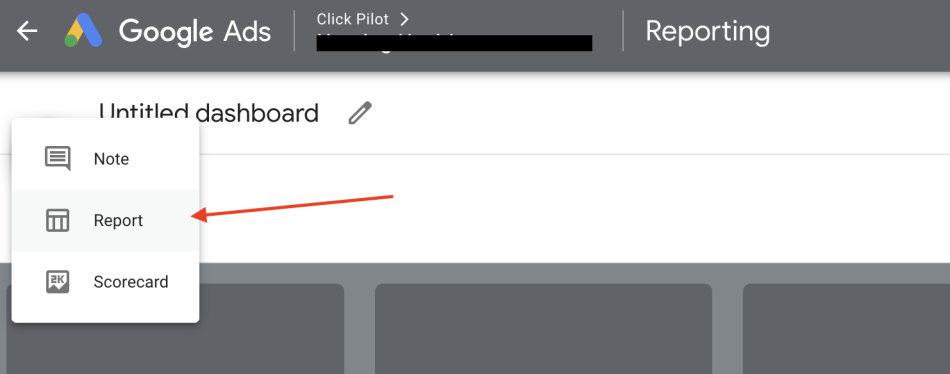
3. Next, add a Row for 'Campaigns' and columns for clicks, cost, conversions and conversion value. After this, apply a filter to view info for Performance Max campaign types only, save the report, and it should be added to your custom Dashboard.
4. You will then need to create another report to view data from Shopping Ads. In this report, add a row for MC ID and columns for Clicks, Cost, Conversions and Conversion Value, and apply a campaign type filter to ensure this shows data for Performance Max campaigns only. When you've done this, add the report to your new Dashboard, and you should end up with something similar to the screenshot below.

5. Finally, compare the difference in clicks, cost, and conversions between Performance Max campaigns and Google Merchant Centre.
In the above example, the total clicks through Performance Max campaigns were 16,142, but the number of clicks through Merchant Centre was 15,073.
(15073 / 16142 x 100 = 93%)
This would suggest that 93% of traffic from the Performance Max campaigns is, in fact, through Shopping ads, with a very small portion of traffic through other ad formats. However, this may not always be the case, and a high spend in other ad formats for which traffic is not providing a good return on ad spend could reduce your campaigns' efficiency.
In our own tests, when running Performance Max campaigns concentrated on Shopping Ads, we've observed up to 17% higher conversion rates and up to a 30% higher return on ad spend. In some of these cases, we were confident we could achieve higher returns, as we'd previously had Smart Shopping campaigns optimised before the mandatory upgrade to Performance Max imposed by Google.
This isn't to say that prioritising Shopping traffic is the only viable strategy, as the whole idea of Performance Max is to scale into other Google properties to find new sources of sales. So this should be assessed and considered based on your advertising goals. It may not offer a good return but may add an additional sales and revenue source.
How To Prioritise Shopping Ads Within Performance Max Campaigns
Your campaign can run across multiple networks by using Performance Max's creative assets, such as videos, images, headlines, and descriptions. However, by not adding assets and running with just Listing Groups, it is possible to force traffic through shopping ads which are particularly important for those wanting to use Performance Max primarily as a shopping campaign.
If you’ve already upgraded from Smart Shopping or created your Performance Max campaign with assets, then, unfortunately, you won’t be able to remove those assets. Instead, your only option is to create a new campaign or asset group within your campaign(s) and pause the old ones.
When creating a new asset group, you’ll need to provide a final URL and then hit ‘next’ as you would if this was a new campaign, but ignore any requests from Google for additional assets. This will force Google to use shopping ads only, and by default, Google should have added a 'Listing Group', which is where product groups are chosen from your Merchant Centre account. You can also tailor this to target specific product groups if you wish. After configuring the campaign correctly, it will function almost identically to how Smart Shopping worked before.

Tips For Testing Performance Max Shopping Campaigns
Watch Out For Campaign Cannibalisation
When testing Performance Max campaigns, try not to run existing product group targeting on other shopping campaigns. Performance Max carries the highest priority of all campaign types in the account. This means that any products and product groups in other campaigns will cease getting traffic if enabled in Performance Max. So pay attention to this if you plan to test it with specific products alongside other Google Ads campaigns.
Rethink Custom Labels
Custom labels can be useful in creating a campaign structure, particularly when advertising thousands of products. However, when using Performance Max, applying a single custom label to an asset group is now only possible. This could mean that retailers will have to rethink their segment reporting structure or the hooks used to build more complicated campaign structures if they decide to use Performance Max campaigns. If you'd like to know more about evaluating the effectiveness of your campaigns, you can read more about Reporting In Performance Max Campaigns.
Give Performance Max Time To Learn
When implementing Performance Max campaigns, it's important to give it time to learn and avoid making changes during this phase. The learning phase of Performance Max can vary – though, in theory, this phase should be faster if the traffic is concentrated on shopping ads. Google suggests that for Performance Max campaigns focused on online sales, you should wait for one to two weeks before evaluating your campaign’s performance. This allows enough time for the system to learn and make recommended adjustments to achieve your desired outcome.
Maintaining patience while the campaign is in its learning phase is necessary because a lot of optimisation occurs within the first few weeks. We've found that it can take as long as six weeks to see the impact of any campaign changes. When analysing data, remember you need enough data to reach statistical significance, and the first two weeks can't be considered an accurate representation while Performance Max is in its learning phase.

Getting Started With
Performance Max
Download Our Step-by-step guide to getting started with Performance Max Shopping Campaigns for your Shopify Store
GET YOUR FREE EBOOKFREE EBOOK
How To Get The Most Out Of Performance Max
Optimise Your Merchant Centre Data Feed
Optimising your Merchant Centre data feed is essential to achieving great results with Performance Max campaigns. Submitting high-quality data to Google from the start can impact campaign performance the most, so it’s important to ensure you’re submitting as much information as possible. This includes brand, Manufacturer Part Numbers/Global Trade Identification Numbers, descriptive titles (including relevant keywords!), Google taxonomy/categorisation, product type, high-quality images and custom labels.
Providing a rich data feed while considering searcher intent and buyer motivations will help your ads enter more auctions at the right times. This will allow your ads to be displayed in more relevant search results, increasing the chances of attracting clicks and converting into sales.
Teaching The Machine
Audience signals are an invaluable tool for teaching a machine to learn and optimise campaigns for better performance; this process is managed within asset groups. Audience signals help the machine learning algorithms detect new and relevant customer bases, as well as identify trends among existing customers and target them with ads more appropriate to their interests.
Asset groups provide a structural basis for the machine to comprehend these signals, allowing for a faster, more efficient optimisation of campaigns. To better understand how asset groups function and why they are important for optimising campaigns, please refer to our Guide To Performance Max Assets & Asset Groups.
How Should You Structure Your Performance Max Campaigns?
Structuring your Performance Max campaigns can be tricky, especially when there is no reporting on the Asset Group level.
For small catalogues, Generally speaking, combining all products in one campaign is best for smaller retailers with a low product count, say 5-10 products. This way, Google's Machine will have the most data to learn from and optimise the campaign accordingly. However, it may be beneficial for larger stores to break out different products into separate campaigns to improve reporting capabilities and/or optimisation. This could be approached in a number of ways, designed to meet the advertising objectives of the business, but here are some campaign structure ideas to consider.
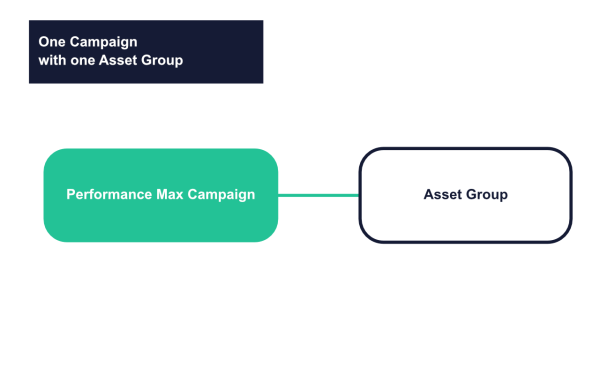
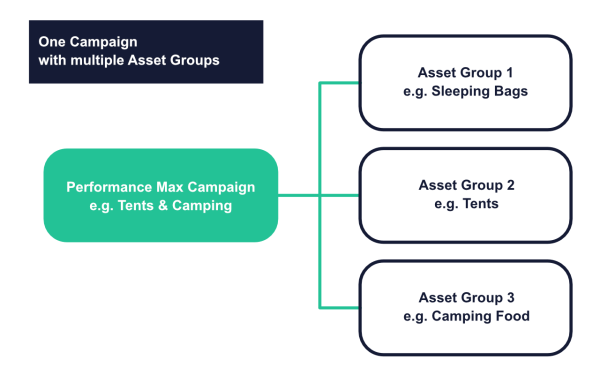
Campaigns / Asset Groups By Category; One option is to create several campaigns and/or asset groups per website category. For instance, you could create separate campaigns for each top category, with asset groups within each subcategory. Some samples for an Outdoor Gear retailer would be;
- Tents & Camping > Tents, Furniture, Cooking & Eating, Sleeping, Accessories
- First Aid & Survival > First Aid Kits, Insect Repellent & Nets, Survival Gear
- Cooking & Eating > Camping Stoves, Tableware & Cutlery, Camping Food, Food Storage & Cool Boxes, BBQ & Gills, Coocksets & Utensils
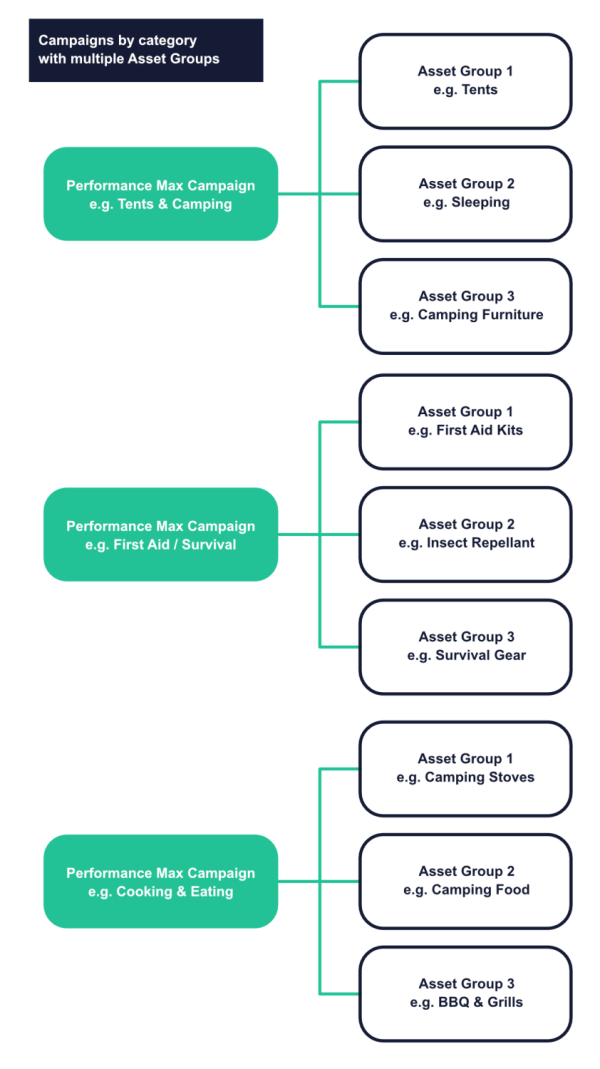
Campaigns / Asset Groups By Objective; Another idea is to structure multiple campaigns around relevant business data and objectives such as stock, margin, price points, or new stock, allowing asset groups to make up relevant ad groups based on the category in which products would reside. This way, ad relevance can be maintained by the ads created and objectives set strategically for the business.
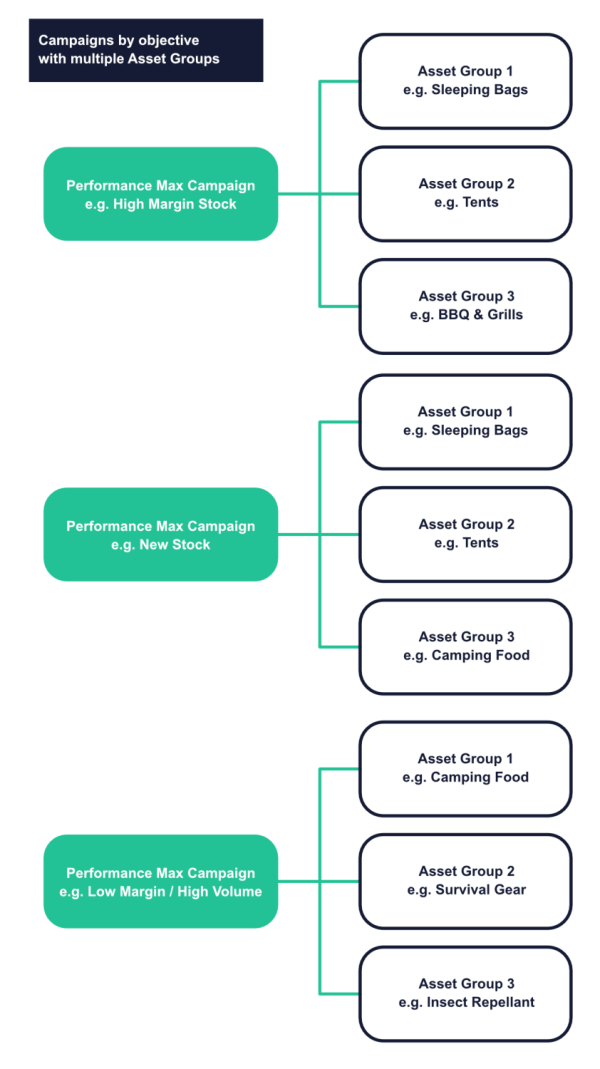
Choosing Budgets & Bid Strategy For PMax Shopping
When deciding on the budget and bid strategy for a PMax campaign, it is important to ensure the two are complementary. If your daily budget is too low and your average cost per action (CPA) is too high, the likelihood of your campaigns ramping up is slim. You are simply not giving Google enough headroom to test new traffic, as would be the case for any PPC Management Agency testing new opportunities.
For larger catalogues with a more complex structure, your budgets and bid strategies should be based on your chosen structure. Though you cannot control your bids, you can control the type of bid strategy used to meet your objectives for each campaign. In the case of a product catalogue with items that have wildly varied prices, you can select “Maximise Conversion Value” as the campaign’s bid strategy, which tells Google to concentrate on achieving the highest conversion value for its given budget (promoting higher-ticket products). You can go further with this to set the desired return on ad spend (ROAS), though this isn't advisable if you are setting up a new campaign.
Conversely, if all of your conversions have the same value, you can select “Maximise Conversions” for the algorithm to focus on all goals equally, and you can go as far as adding a ceiling on the desired cost per conversion (CPA). So this will lend itself well if you wish to promote all your products regardless of value and if your margins are all the same.
With the above strategies set, Performance Max automates bidding and budget strategy, making it easier for advertisers to manage their campaigns without manually adjusting bids and budgets.
Select The Right Conversion Goals
When creating your conversion goals within Google Ads, selecting the right goal based on your website’s purpose is important. If you sell products online, choose ‘Purchases’ to track completed sales. If you are offering services such as consulting, choose appropriate actions such as “Phone Calls”, “Form Submissions”, or “Live Chats” to measure your success in garnering leads.
For Performance Max for Retail, tracking sales online with associated basket value is important. Google will use this data in its bid optimisation, especially when going with value bidding as one of your strategies. So ensure your conversion tracking is set up correctly and reporting dynamic basket values.
Tips For Advertising New Products & Products With No Traffic
As a result of products not getting enough traffic, Google may get into a self-reinforcing loop where it doesn’t know the conversion rate and hence stops testing such products to maintain conversion objectives. These might be products you wanted to prioritise due to high stock levels or being end-of-season. The same may be true for new products, where Google lacks any historic performance on which to base any bidding strategy.
In the above cases, you'll want to get traffic to these products to give them any chance of selling. To help revive them, try breaking these products out into their own Performance Max campaign, maybe with a ‘Maximise conversions’ strategy, as this will enable Google to learn from the impressions your product gets.
As a further step, you could do the same but with a Standard Shopping Campaign and use a Maximise Clicks or manual bid strategy to get ad impressions and traffic to your low-traffic products. Once they begin to get traffic and sales, Google will have some sales data, which can be re-inserted into your core campaign structures.
Trouble Shooting Performance Max Campaigns
Low Or A Sudden Drop In Traffic
There may be times when your PMax Campaigns are humming along nicely, only to see a sudden drop in ad clicks and sales with no clear explanation. This will be obvious when looking at overall metrics for your campaigns, such as trends in impressions, clicks, and conversions, but not so obvious in diagnosing the problem. If you're not getting enough impressions or conversions, there may be issues with your targeting or ad creative. Here are some things to investigate.
Check Your Merchant Centre Feed
When you are using Performance Max for retail ads, you must first check your Merchant Center Feed. This feed is what powers Shopping Ads within Performance Max and can often account for a large portion of your traffic. Any issues with the Merchant Center Feed may result in Shopping Ads being disabled while Performance Max continues running on other networks with fewer clicks and lower conversion rates.
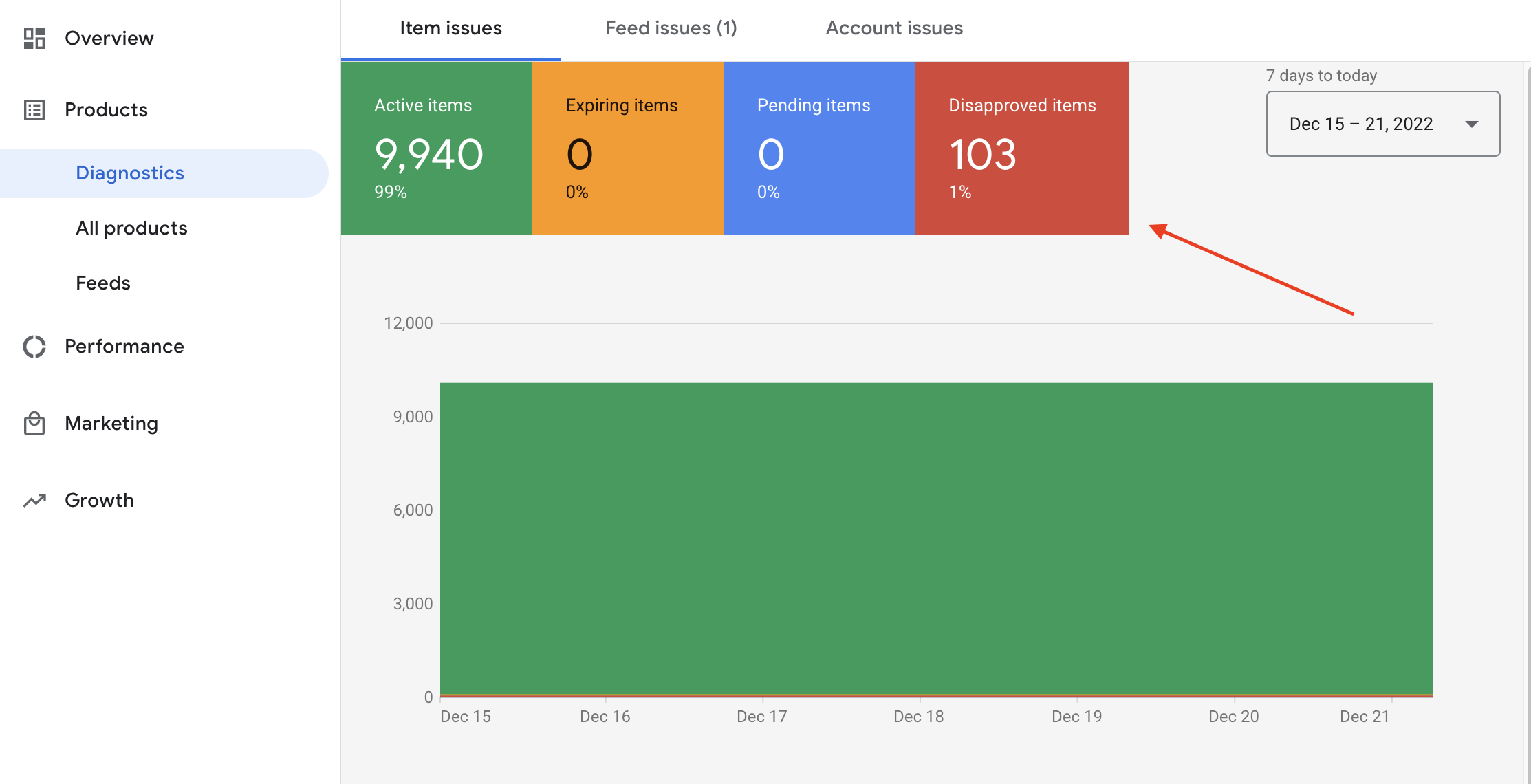
It is important to observe if there are more product disapprovals than usual or if your top-selling products have been removed from the feed. Additionally, a drop in product count should be taken into consideration.
This information will be available in your Google Merchant Center by accessing 'Diagnostics' for Shopping Ads on the main dashboard. By checking the feed, you can quickly identify whether an issue with it is the root cause of any problems. Changes in product count or disapprovals that coincide with the changes in your traffic are a good indication of where the problem lies. Should this be the case, you must review your shopping feed data source to locate and resolve the issue.
Have You Changed Your Product IDs
One that's easily missed, but when products are sometimes re-uploaded to websites or product feeds, the ID in the product feed changes. This can be a mistake in allocating this ID or something a website does automatically when new product pages are created and the new ID is passed to the dynamic shopping feed. In these cases, Google sees the product as a new one. Even if the product existed on the website before but under a different ID, Google won't associate historic traffic and conversion data with it, so it will begin its optimisation process all over again.
Ad Creative
It is important to regularly review your ad creative to ensure that it is relevant, engaging, and aligned with your campaign objectives. Different ad variations should be tested to determine which ones perform best, as this can help you optimise your campaign to generate the most desired results. This may depend heavily on how you have structured your campaigns and asset groups.
Additionally, you should check to see if any of your assets are disapproved, as this can negatively affect your campaign's performance. Regularly assessing your ad creative will allow you to make necessary changes to get the greatest returns from your campaign.
Check Your Listing Groups
This is especially important if your traffic is focused on Shopping Ads, make sure you have the correct product groups applied to your asset groups and the products included are not disapproved (read about checking your Merchant Center Feed above)
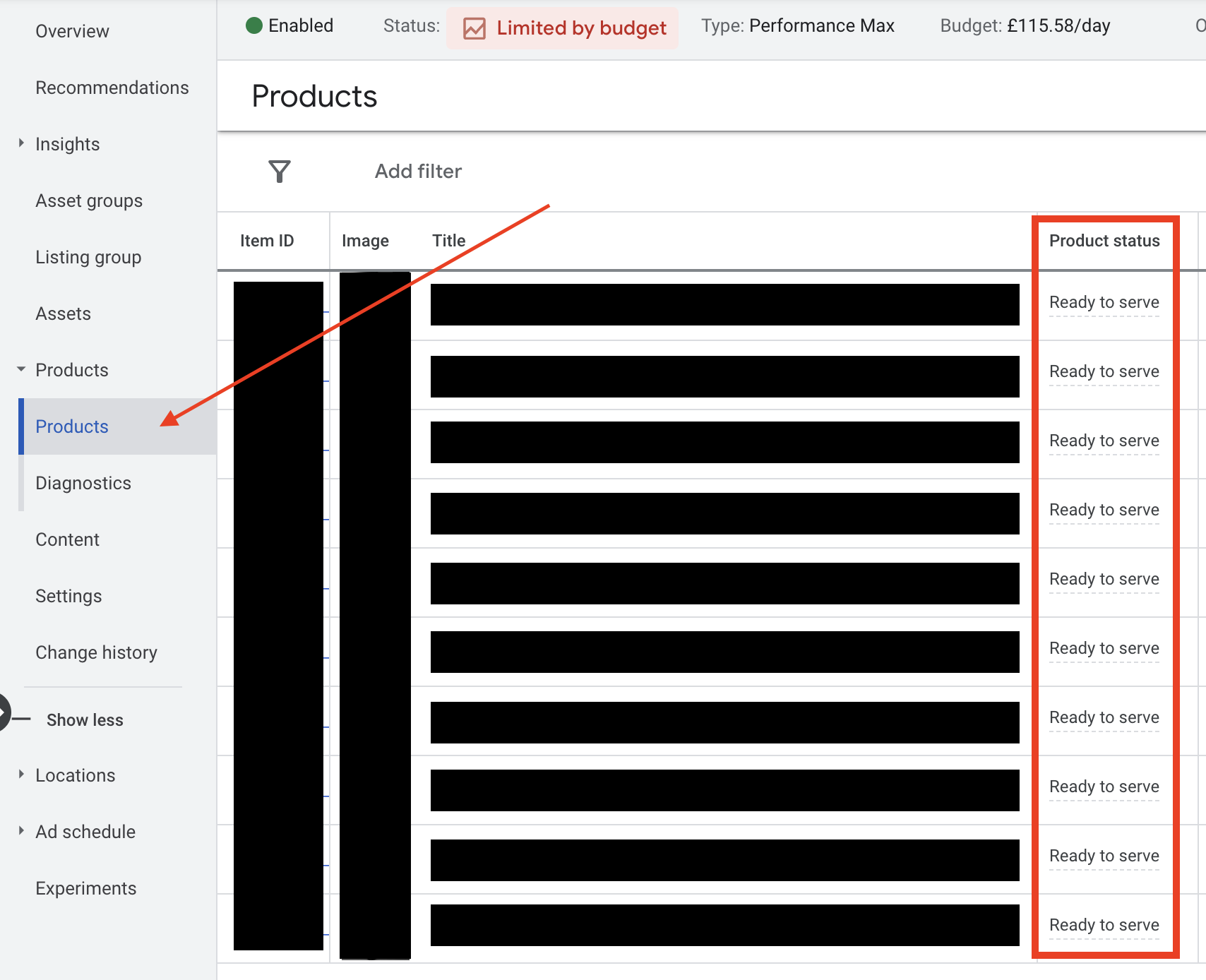
Check Your Bid & Budget Strategy
Ensure your bids and budget are set correctly for your campaign goals. Consider adjusting your bids or budget to see if it impacts performance. Is your budget too low, or are your objectives out of reasonable reach based on historic data? In this case, reducing your ROAS target closer to short-term averages may help recover traffic and sales.

To Wrap Up
Whilst we can conclude from our own data that we see waste in spend when PMax accesses traffic from all networks when using assets, there were some accounts that performed well outside of this trend. And that focusing traffic through Shopping Ads can boost the return on ad spend by up to 30%. There were some exceptions and therefore confirms that this is something that should be investigated and tested using the steps in this post.
There is no indication of any coming updates to Performance Max that offers advertisers the choice of which network access, so recognising your objectives is key, and configuring your PMax campaigns accordingly at present is your only option.
Need Support With Google PMax Campaigns?
The advice in this guide can help online retailers plan and implement more effective Performance Max campaigns. Everything we note here is based on our experience, and we'll update posts on this subject as PMax evolves.
If you're looking for ways to take your Google Ads campaigns to the next level and require a Google Performance Max Agency, we can help. Just get in touch!

Book A Discovery Call
Looking for tailor-made PPC strategies? Our team is here to help you maximize your online store's potential. Book a discovery call with us for personalised insights and solutions.
Book Your Free ConsultationBook Your Call